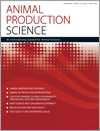
Animal Production Science
Volume 60 Number 13 2020
AN19621Welfare of beef cattle in Australian feedlots: a review of the risks and measures
Society is becoming increasingly concerned about the welfare of animals kept in intensive production systems. This review examines the risks to welfare for beef cattle within commercial feedlots in Australia and identifies established and developing measures of welfare. To allow the industry to show continuous improvements in welfare, accurate, reliable and repeatable measures of welfare are needed to quantify the physical and psychological state of cattle in these systems.
AN19621 Abstract | AN19621 Full Text | AN19621PDF (492 KB) Open Access Article
AN19224Saline water intake effects performance, digestibility, nitrogen and water balance of feedlot lambs
The effect of water with different levels of salinity was investigated on the productive performance and the nutritional status of Santa Inês sheep. The supplied waters contained 640, 3200, 5760 and 8320 mg/L of total dissolved solids. Results showed that the water with a concentration of total dissolved solids of up to 8320 mg/L can be used as drinking water for Santa Inês sheep.
The most limiting dietary nutrient for early lactating cows is energy; thus, fulfilling their requirements are a great challenge for the nutritionists. We attempted to examine the inclusion of palmitic acid-enriched fat in early lactating cow diets to be an option to support additional production and lessen the detrimental responses as well. We showed that the involvement of palmitic acid-enriched fat in cows diets increased milk yield, fat content and feed efficiency; however, it enhanced fibre digestibility and early lactation recovery of body condition and alleviate the prejudicial effects of metabolic disorders.
AN18498Intake, digestibility and feeding behaviour of grazing dairy cows supplemented with common bean (Phaseolus vulgaris L.) residue
Animal performance is often limited by the availability of forage in arid and semiarid regions. The present study was undertaken to evaluate the use of common bean residue as alternative foods in the concentrate supplement of lactating dairy cows. The present study showed that common bean residue up to 240 g/kg may be included in the diets of lactating dairy cows managed on pastures.
AN18668Dried whole cupuassu (Theobroma grandiflorum) nuts as an alternative energy feedstuff for beef cattle grazing tropical pasture
 , E. D. Batista, A. S. Oliveira
, E. D. Batista, A. S. Oliveira  , S. R. Silva, H. Stinguel, P. R. Rocha, J. C. Ortelam, K. R. Santos, L. M. Socreppa and K. A. K. Moraes
, S. R. Silva, H. Stinguel, P. R. Rocha, J. C. Ortelam, K. R. Santos, L. M. Socreppa and K. A. K. Moraes
Cupuassu is frequently cultivated in Brazil as well as in the warm lowlands of other tropical American countries. The present research investigated the effects of the level of substitution of maize with dried whole cupuassu nut (DWC) in concentrate supplements for grazing beef cattle. It is hypothesised that the DWC cannot fully replace maize in the supplements due to the presence of theobromine and higher ether extract content. The substitution of maize with DWC reduces the intakes of DM of both supplement and pasture in grazing beef cattle.
AN19319Changes in performance, egg quality and blood parameters of laying hens fed selenium and oregano oil
Organic products from animals (i.e. free of antibiotic residues) are gaining popularity among consumers, and selenium is a key mineral for animal and human body function. In this research, the effects of organic selenium and an herbal additive (oregano) on productive performance of laying hens and egg quality were examined. The results suggest that oregano may be helpful to improve egg production in hens fed diets containing organic selenium.
Gastrointestinal worms are becoming increasingly resistant to the available anthelmintics and are the major cause of diarrhoea in the winter rainfall regions, resulting in loss of production and increased costs for drench and labour (Besier et al. 1996). Elucidation of the underlying mechanisms of diarrhoea and associated immunological changes throughout the year in worm-resistant and worm-susceptible sheep should help the development of effective worm management and breeding systems. This study found no physiological differences within a season for a wide variety of circulatory haematology blood traits between extreme genotypes for worm resistance and diarrhoea. However, large differences were found among sampling times (i.e. different seasons), probably because of differences in worm challenges during each season.
Intestinal worms have been estimated to cost the sheep industry annually $436 million in production losses and from anthelmintic treatment costs. The inappropriate use of anthelmintic drenches has also resulted in an increase in the parasites becoming genetically resistant to the drenches. This study showed that sheep that were genetically similar in production, but differed genetically only in resistance to worms, were more productive and required fewer anthelmintic treatments.
AN19349Volatile and sensory analysis to discriminate meat from lambs fed different concentrate-based diets
Lamb meat has a distinct flavour, which may be influenced by the animal’s diet, leading to effects on consumer acceptability. The present study investigated the effect of four different cereal-based diets, including different fat sources, on lamb flavour, with the results showing minor differences. The findings showed that certain ingredients, including by-products, may be included in lamb diets, resulting in an altered fat profile, without negatively affecting the sensory quality and palatability of lamb, but enabling discrimination due to diet.
AN17809_COCorrigendum to: Improved region-specific emission factors for enteric methane emissions from cattle in smallholder mixed crop: livestock systems of Nandi County, Kenya
AN17809_CO Abstract | AN17809_COCorrigendum (325 KB) Open Access Article



